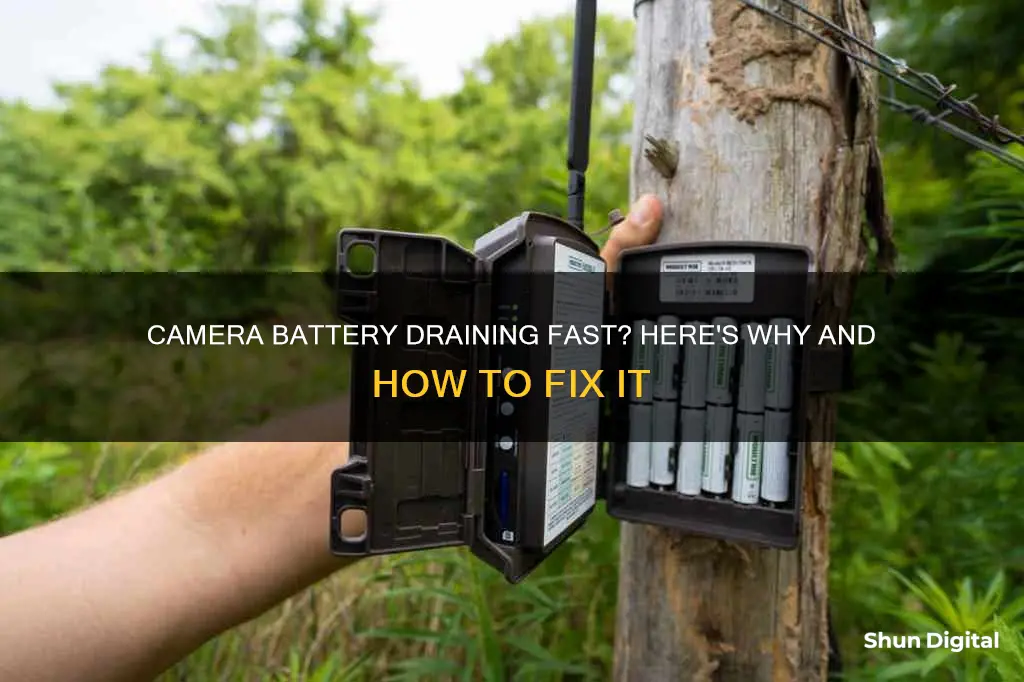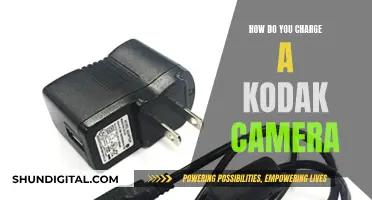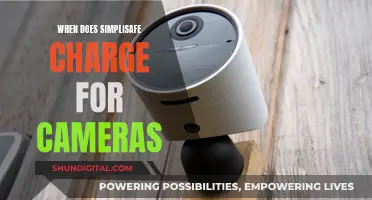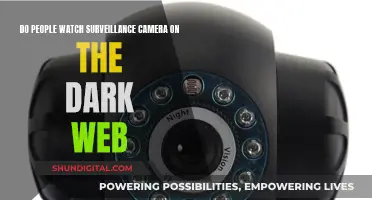
There are several reasons why your camera battery might be draining quickly. Firstly, digital cameras require a lot of power to run efficiently, especially the monitor (LCD) and flash. Using the LCD screen drains the battery faster than a viewfinder, so try to reduce your LCD usage and turn down the brightness. Other features that drain the battery include automatic flash, continuous autofocus, and shooting in RAW. Cold weather can also affect battery life, as can leaving your camera in record mode and forgetting to activate power-saving mode. If your battery is old, it may be time to replace it, and always check for corrosion, especially if the camera has been stored in a humid environment.
What You'll Learn

Using an LCD screen instead of a viewfinder
The LCD screen is one of the most significant battery drains in a digital camera. Using the LCD screen to frame shots will result in you needing to recharge your camera more regularly.
If your camera has a viewfinder, using it instead of the LCD screen can extend your camera's battery life. When you use the LCD screen, you are not only using it to view shots taken but also to line them up. This is a significant power drain.
If you must use the LCD, turning down the brightness can help preserve the battery. You can also avoid excessively scrolling through stored photos or cycling through the camera's menus.
- Steadier Camera: It is easier to hold the camera steadier when it is held up to your eye to use the viewfinder. This is because the camera is supported and steadied by your hands and torso. When using the LCD screen, the camera is held at arm's length, increasing the chance of blurry shots.
- Less Battery Drain: The LCD screen on your camera consumes battery power faster than almost any other feature. Using the viewfinder instead will significantly reduce the power drain and extend your camera's battery life.
- More Precise View: The human eye can resolve more detail than an LCD screen. You get a sharper and more accurate view of your image by using the viewfinder. Optical viewfinders, even on professional DSLR cameras, show 90-95% of the image, while the LCD screen displays the entire frame captured by the sensors.
- Better in Bright Conditions: Framing shots using the LCD screen in bright sunlight can be challenging due to glare and washout. The crystals in LCD screens can also flare in bright sunlight, further worsening the issue. Using the viewfinder instead of the LCD screen generally overcomes this problem.
- No Parallax Issues: One common complaint about using the viewfinder on digital cameras is the parallax problem, where what you see through the viewfinder is slightly different from what the camera lens sees. This is because the viewfinder is positioned above and to the left of the lens. While some viewfinders provide a guide to framing the shot, it can still be tricky, especially for close-up or macro shots.
Charging the Garmin Virb: Battery Power Explained
You may want to see also

Not using power-saving mode
To enable power-saving mode, explore your camera's settings. Refer to your camera's manual for specific instructions on how to access and activate this mode. Once enabled, power-saving mode will help preserve your battery life by reducing power consumption during periods of inactivity.
Additionally, the LCD screen is one of the most significant power drains in a digital camera. If you have power-saving mode enabled but still experience rapid battery drain, consider reducing your LCD usage. Instead, use the viewfinder to frame your photos, and remember to turn off the LCD screen when not in use. You can also lower the screen's brightness to conserve battery power further.
Another factor to consider is the use of battery-intensive camera features. Certain functions, such as automatic flash and built-in Wi-Fi, can consume a significant amount of power. If you're experiencing rapid battery drain, try reducing your usage of these features. For example, adjust your camera settings to minimise the use of the flash when shooting conditions allow.
It's also worth noting that rechargeable batteries tend to lose their ability to hold a full charge over time. If you've had your rechargeable battery for several years, it may be time to replace it. Consider investing in a high-quality rechargeable battery to ensure your camera has sufficient power for extended periods.
Camera B500 Charging: Cable or No Cable?
You may want to see also

Using a bigger lens
When capturing certain types of photos, such as portrait photography or landscape shots from a distance, a telescopic lens may be necessary. However, for other types of shots, you can opt for a smaller lens, such as a wide-angle lens, and crop the photo later if needed. By choosing a smaller lens when possible, you can help conserve your camera's battery life.
Additionally, lenses with image stabilization or vibration reduction features can also contribute to increased battery drain. These features are designed to reduce blur and improve image quality, but they require additional power to function. If you don't need these features for a particular shot, turning them off can help extend your battery life.
To maximize your camera's battery life, it's important to consider the type of lens you're using and choose the appropriate lens for the situation. By opting for smaller lenses when possible and being mindful of the power requirements of different lenses, you can help ensure that your camera battery lasts longer between charges.
Charging Your A6000: A Step-by-Step Guide to Powering Your Camera
You may want to see also

Corrosion on the battery
Corrosion typically appears as green or brown smudges on the metal connectors of the battery. If you notice corrosion, it is important to remove the buildup so that the battery can charge properly. You can use a baking soda and water solution, or a soft drink containing carbonic acid, to remove the corrosion. Brush the solution onto the terminals with a toothbrush and then wipe them clean with a damp cloth. You can also use sandpaper to clean the terminals. Once they are dry, apply some grease, Vaseline, or petroleum jelly to the terminals to prevent further corrosion.
To prevent corrosion from occurring in the first place, make sure that your camera battery is not being overcharged or undercharged. Check the manufacturer's manual for the recommended battery voltage and use a multimeter to check the voltage of your battery. If your battery is more than a few years old, it may be time to replace it, as rechargeable batteries lose their ability to hold a full charge over time.
Powering Qarlo Cameras: How Many Batteries Do They Need?
You may want to see also

Cold weather
Firstly, it is recommended to carry spare batteries with you, as they will inevitably drain faster despite your best efforts to keep them warm. Keeping these spares close to your body, such as in an inner pocket or a fanny pack, can help maintain their warmth and prolong their charge. You can then swap these batteries with the one in your camera as needed.
Secondly, it is beneficial to keep your camera and its battery warm when not in use. Consider wrapping your camera in a sweater or an extra layer of clothing and placing it in your backpack. This will help insulate it and slow down the battery drain. Additionally, if you're in a vehicle, you can utilise the car heater to warm up your batteries before heading out.
Another suggestion is to avoid using certain camera functions that are known to drain batteries quickly, such as Live View. Instead, use the viewfinder to frame your photos, and remember to turn off the camera between compositions.
Lastly, be mindful of recharging your batteries. While in cold environments, it is best to recharge them at night, keeping them warm inside a sleeping bag or near a heater. Avoid charging during the day in cold temperatures, as this can shorten the battery's lifespan.
By following these tips, you can effectively manage your camera's battery life during cold weather and ensure you're prepared for your photography ventures.
How to Keep Your WiFi Camera Charged and Ready
You may want to see also







